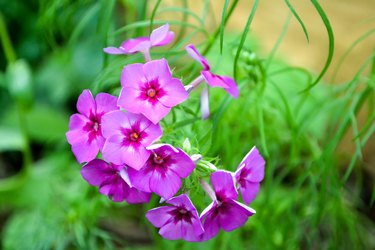
The bright shades of phlox are a welcome sight in the garden after a long winter. Whether it's the first sign of spring creeping phlox (Phlox stolonifera) or the tall garden phlox (Phlox paniculata) plants of summer, there is a phlox that fits every garden and provides colorful blooms almost all season long. Good for cut flowers, tall garden phlox also attract butterflies and hummingbirds.
Phlox Bloom Time
Video of the Day
A common spring sight, creeping phlox produces a dense, low-growing mat of color. Blooming from April through June, creeping phlox blooms heavily for about three to four weeks. It's available in a wide assortment of colors including pink, white, mauve, red, blue, and purple and makes a striking statement along garden edges.
Video of the Day
Garden phlox grow to 4 feet of brilliant color and bloom July through to mid-September. The plant blooms for 6 weeks or longer once they start blooming. A low-maintenance plant, garden phlox is available in bright shades of magenta, white, pink, red, and blue.
How to Plant Phlox
All phlox prefer full sun, but they'll also perform well in partial shade. Plant phlox in moist, well-drained soil that has been amended with a few inches of compost. Garden phlox can grow to 2 feet in width at its base, so when planting phlox, give them plenty of room to spread.
Dig a hole comparable in size to the container the plant was grown in. Position it so the top of the root ball is level with the soil surface when it's planted. Fill in the hole, water the plant well, and add a layer of mulch to help maintain moisture and deter weeds.
How to Care for Phlox
Add a layer of compost and mulch each spring to continue to deter weeds and keep the soil moist. Deadhead the faded flowers on garden phlox to promote new and continued blooms and prevent reseeding. Divide the plants every three years. In the fall after the first heavy frost, cut tall garden phlox back to 2 inches above the base of the plant.
Powdery mildew is a common affliction of phlox, and dividing regularly and providing added air circulation can help reduce the severity of the disease. Powdery mildew won't harm the plant, but it does cause the leaves and stems to develop a grayish-white coating, which may turn yellow, and fall off the plant. As a result, mildew-resistant cultivars are becoming available at garden centers.
Phlox Flower History
It was John Bartram in the 1740s who introduced phlox to England where it was then grown in many estate gardens. It became a flower garden staple in the 1850s as people found more leisure time and gardening became popular with many homeowners. In 1837, alternative varieties of phlox began to emerge, and garden phlox remained popular until the 1930s when annuals took over as the garden plant of choice. It wasn't until the 1990s that perennials bounced back onto the gardening scene and the phlox has remained a common sight in many perennials gardens ever since.